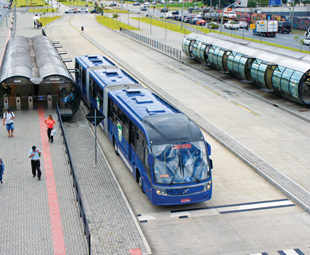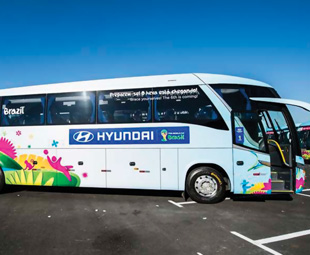Can SA make its cities more transit-oriented?

The world’s leading cities owe their success, in part, to government investments in transit systems that use a range of solutions to move residents safely and affordably, including bus rapid transit (BRT) networks. CLAIRE RENCKEN takes a look at what the South African bus industry can learn from the rest of the world.
Let’s start by looking at cities like New York and San Francisco. Both boast a sustainable, pedestrian-friendly urban form that reduces the need for cars. Transit-oriented cities have better air quality, with lower greenhouse gas emissions and benefit from reduced traffic congestion with shorter commuting times.
Evidence even shows that people in cities with a range of transportation options, like Vancouver, are less sedentary, get more exercise and are happier and healthier as a result.
There’s growing recognition that prioritising transit is crucial to moving a region forward. For example, since the 1970s, Curitiba, Brazil – a city with a population of 1,9 million people – has invested billions in its BRT network. There, public transportation is fully integrated into planning decisions.
High-density hubs with shopping centres and office buildings are located within walking distance of transit stations and commuters have access to a fleet of more than 2 000 modern, low-emission buses, servicing 390 routes that crisscross the city and connect it to surrounding communities. Eighty-five percent of Curitiba’s residents use the BRT system, which has reduced car trips by a whopping 27 million a year.
Toronto’s Thorncliffe Park also illustrates how transit investments can improve residents’ lives. In his book, Arrival City, Globe and Mail columnist Doug Saunders argues that easy access to transit, among other factors, is one reason that Thorncliffe Park has avoided many social problems that plague similar inner-city neighbourhoods. Though most residents are recent immigrants, half speak a first language other than English and many are poor, Thorncliffe Park residents integrate well into Canadian society, and many enter the urban middle-class within a generation.
Saunders believes this is in part because the neighbourhood is well connected to Toronto’s downtown, with bus and subway routes, and has easy access to schools, employment and other opportunities. Transit facilitates social and economic links to the core of the city and helps residents overcome the physical isolation that plagues many communities.
In terms of logistics and being user-friendly, Vaughan Mostert, senior lecturer in the Department of Transport and Supply Chain Management at the University of Johannesburg, feels that London’s public transport system is arguably the best example of a good one, at least in the English-speaking world.
“Not only does it use the latest technology, but its operating practices are good as well. This means good frequencies (every ten to 15 minutes), good route coverage, a good ticket system that allows transfers, a fairly easy-to-use website that shows maps and times, and an easy-to-read font and logo that is common on all documents, publicity material and destination signs.”
Paul Browning, a public transport consultant with TransForum Business Development, says: “The most significant lesson that our public transport industry might learn from other developed countries is that, in almost all of them, public transport services are planned in an integrated fashion by local/metropolitan authorities and operated under contract by private companies. The operating companies are paid a rate per kilometre designed to meet all their operating costs plus an agreed amount for profit.
“This is indeed the pattern described in the South African National Land Transport Act (NLTA) 2009. Implementation is, however, proving to be very slow. One reason is that the emphasis has been on BRT systems, which are infrastructure-led. The bus companies should press for urgent implementation of the relevant provisions of the Act.
“The Act provides for the first such contract to be negotiated with existing operators rather than put out to competitive tender. It also states that these first contracts can be for a period of up to 12 years.”
So, perhaps South African bus companies should agitate for the implementation of the NLTA throughout the country. “In doing so, they might point to the practices adopted in other countries,” suggests Browning.
At present, in Gauteng there are plans for another 140 km of Gautrain to be built. On June 15, the Sunday Times published an article stating that the new line from Mamelodi to Roodepoort “has been given the green light by the Gauteng government”. The new network will see an additional 16 stations being built.
However, Mostert is not so sure about the wisdom of this decision. “Despite the promises of systems such as the Gautrain and the various BRT systems around the country to reduce the number of cars on the roads, to ease traffic congestion and reduce harmful emissions, no real difference has been recorded to date. This begs the question – would it not be better to take R20 billion and rather inject it into improving existing transport systems?”
One could, for example, pump it into the taxi industry, and improve and upgrade what is already there, in order to provide people with a real door-to-door alternative, truly incentivising them to use public transport rather than hopping in their own cars.
Effective transit and transportation solutions can spur economic productivity, protect the environment and improve quality of life. It’s time to get moving!
How did Brazil do it for the 2014 FIFA Soccer World Cup?
 More than 1 000 Hyundai vehicles were used for ground transportation at the recent Soccer World Cup in Brazil. As one of the official partners, the South Korean vehicle manufacturer delivered 1 021 sedans, sports utility vehicles and vans to be used as official transportation during the tournament.
More than 1 000 Hyundai vehicles were used for ground transportation at the recent Soccer World Cup in Brazil. As one of the official partners, the South Korean vehicle manufacturer delivered 1 021 sedans, sports utility vehicles and vans to be used as official transportation during the tournament.
To support its fleet, Hyundai Motor Brazil (HMB) deployed service teams to all the World Cup stadiums and FIFA facilities. Prior to the delivery, HMB’s service team trained over 1 000 drivers to become familiar with each model, as well as to learn about maintenance, safe driving techniques and routes.
Since Hyundai Motor signed its 1999 sponsorship agreement with FIFA, the company has served as its official partner during the 2002, 2006, and 2010 World Cups. Following on from Brazil, the deal will also extend to the Russia 2018 and Qatar 2022 tournaments.
Published by
Focus on Transport
focusmagsa




